In the previous post in this series I discussed how Netrunner served as a starting point for the Worldbreakers snake-like round structure. Another mechanic that inspired Worldbreakers is Netrunner’s agenda.
Winning in Netrunner requires agenda cards, which represent precious, highly sensitive data. Each agenda is worth some amount of agenda points (typically between 1 and 3), and the players are each trying to be the first to reach 7 agenda points.
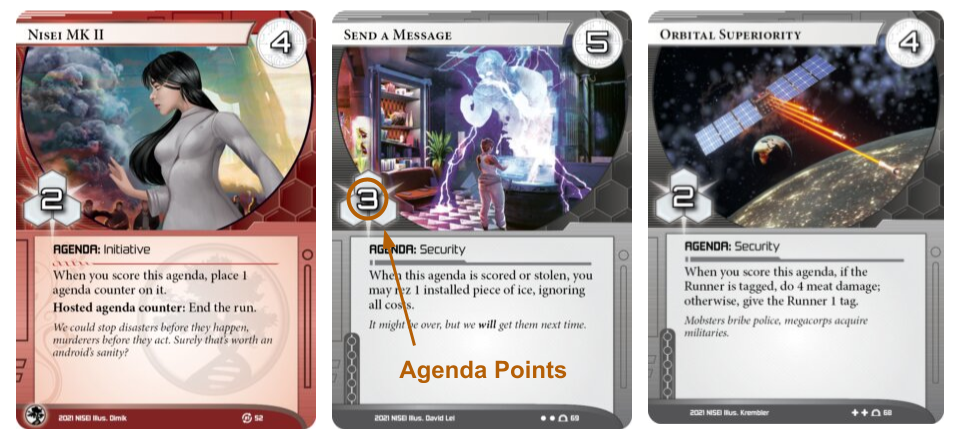
Netrunner is an asymmetric game where each player has a different set of rules. The Corporation player has the agendas in their deck, and scores them by playing them to the board and then investing time to complete them. On the other hand, the Runner instantly steals any agendas they access. This creates a tense game of cat and mouse, where the Corporation attempts to identify windows where agendas can be scored safely while the Runner wants to balance building their board state while maintaining a threat.
The agenda mechanic highlights two of my favorite aspects of Netrunner:
- Building up toward victory
Your goal is to gain a certain amount of points, unlike other games (such as Magic: the Gathering), where you are trying to directly harm your opponent. - Getting points is dangerous
Both sides are putting themselves at risk when trying to score or steal agendas. Timing is critical: you want to make your move when your opponent is most invested in their own plan.
I was looking to bring that dynamic to my game, under a severe design restriction: Worldbreakers is a symmetric game (and more on that in a later post). The result was the Worldbreakers location cards.
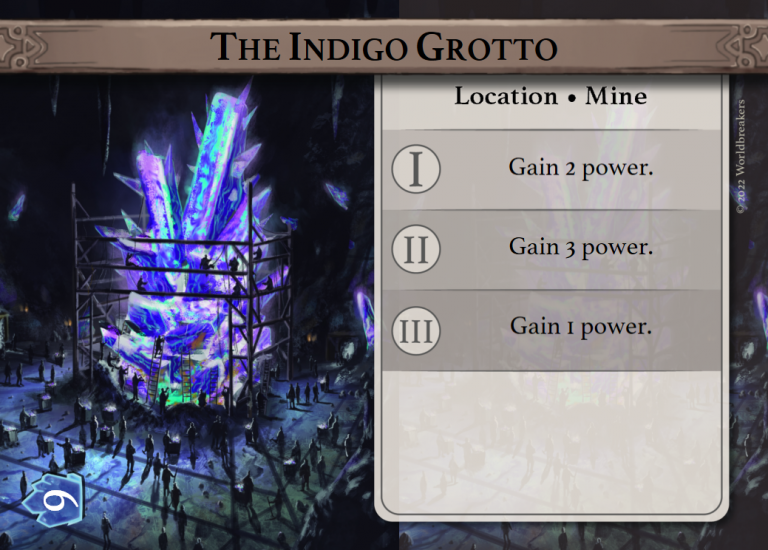
Each location has an ordered list of abilities called stages. When you play a location, you place a stage counter on each stage. Then, as an action, you can develop a location, investing time to trigger the effect. This mimics the Corporation’s agenda-scoring mechanic from Netrunner. Using The Indigo Grotto as an example, the first stage will gain two power, the second stage will gain three power, and the third will gain one power. A total of six power gets you a long way toward victory, since 10 power wins the game.
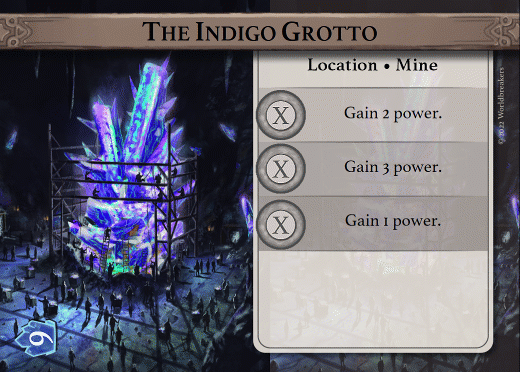
In addition to gaining points, Netrunner agendas have abilities that trigger when they are scored. Similarly, stage abilities can do things other than gain you power.
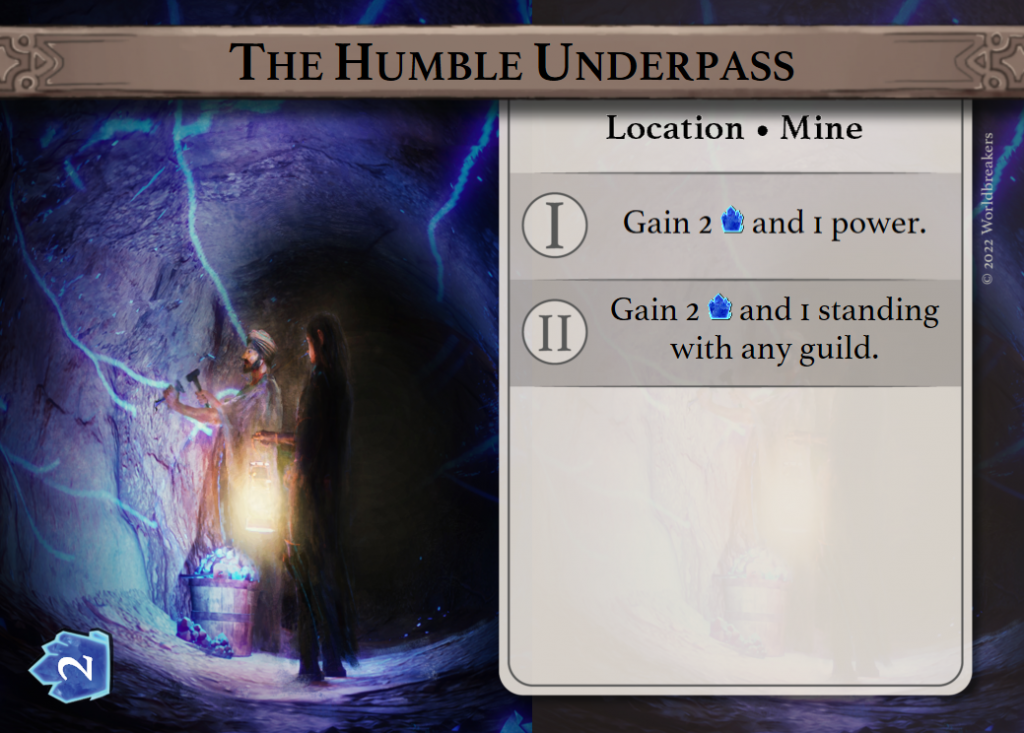
Locations vary wildly based on their cost, number of stages, and their effects. While the aforementioned Indigo Grotto is an expensive, direct path to victory, The Humble Underpass is a lower risk investment that provides other key resources: mythium and standing.
Another difference between Worldbreakers and Netrunner is that the latter has hidden information as a core mechanic. Most of the Corporation’s cards are played face down, including agendas. The Runner can never be sure whether the server that they are running has an agenda or a trap. Since Worldbreakers does not include that unknown element (and more on THAT in a later post!), your opponent knows when you play a location. It’s always a risky move.
In order to mitigate some of that risk, I made two big changes to how your opponent interacts with locations. One, your opponent does not steal your locations or their stages. If they successfully attack, they only damage a location, removing the top stage counter without triggering the stage effect, losing you one of the location’s abilities. Two, in Netrunner, one side gets all of the agenda points. However, Worldbreakers locations are developed one stage at a time. Even if your opponent damages a location, you could gain at least a partial benefit from it.
Splitting locations into stages introduced a whole universe of design. The Humble Underpass above only gains you standing on the second stage, making it a slow source for standing. Another example is Luminous Lagoon,
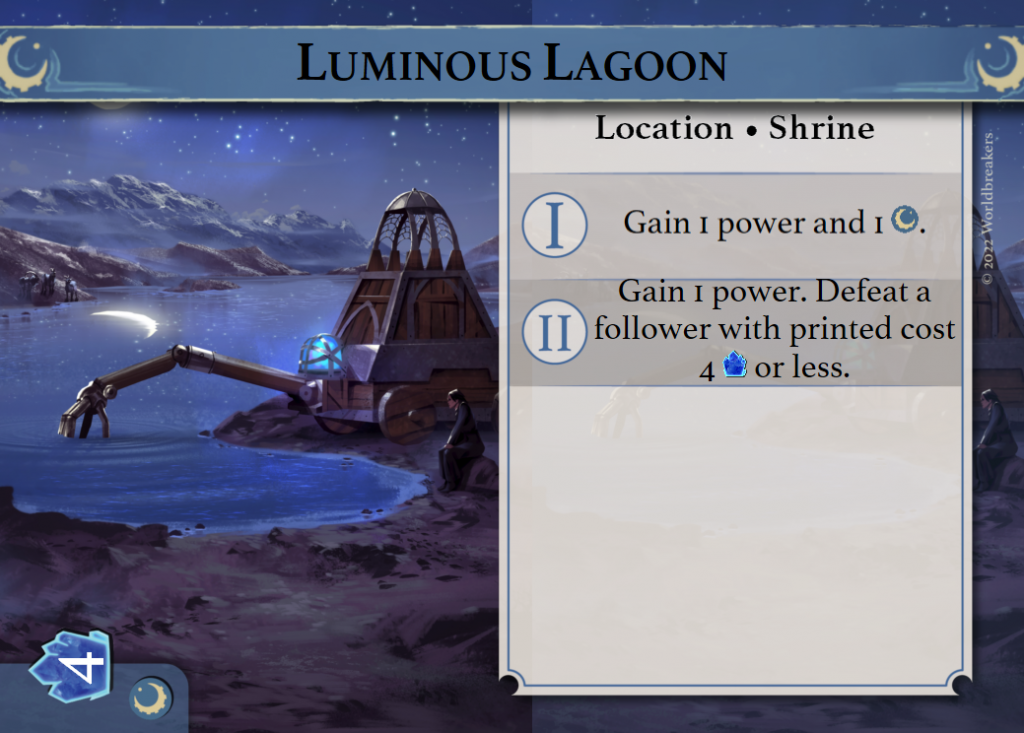
The second stage on this location has the impactful effect of defeating one of your opponent’s followers (discarding them from play). Given the alternate turns structure of Worldbreakers, this introduces a tricky test for both players. If your opponent attacks after you play the Lagoon, you will lose out on the first stage but could immediately develop the second stage and nab one of their followers. Alternatively, your opponent could wait with the attack until after you develop the first stage in order to prevent you from developing the second stage (and from defeating their follower). You could then decide not to develop the Lagoon at all until you have a more secure position. This game of chicken continues until someone decides to make a move.
Locations are a crucial source of tension in Worldbreakers, since they are an origin of power, resources, and other game-altering effects. This tension is amplified by the game’s round structure and alternate turn system, which adds a delicate sequencing puzzle. Together, they make Worldbreakers a challenging test of reading your opponent to time your moves.